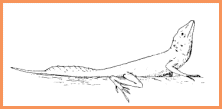ABOUT THE CULEBRA ISLAND GIANT ANOLE

- The seldom-seen Culebra giant anole (a huge lizard),
resides in the forested areas of Mount Resaca, in the
Culebra Island, Puerto Rico.
- Chapman Grant first described it in 1931 as a
brownish-gray lizard growing to about 160 mm from its
snout to the vent.
- The Anolis Roosevelti was named after Teddy Roosevelt,
who was the governor of Puerto Rico at the time.
- Grant first saw the specimen when a small child on
the island brought it to him.
- In 1932 another specimen was collected by a local
resident and brought to Grant.
- It was an adult specimen, which truly distinguished
the two types of anoles found on the island from
each other.
- That was the last specimen seen by a biologist.
- Since its discovery in the 30ís, the species has
almost been ignored.
- The Culebra Island giant anole, known only from
Culebra Island, seems to have become extinct in the
wild and thus represents the first of Puerto Rico's
reptiles known to have become extinct since
Columbus's arrival.
- The natural history and ecology of the Culebra giant
anole are unknown.
- The only reason the specie is still on the endangered
species list is because of two specimens, which are
located at the University of Michigan Museum of
Zoology and at Harvard University.
- In life, the color is brownish-gray with two lines
on each side, one from ear to groin, and the other from
shoulder to groin.
- There is a distinct spot on the temple and the
eyelids are yellow.
- The tail is yellowish brown and the throat-fan is
gray except for the lower posterior quarter which is
light yellow.
- The underside of the belly is whitish.
- In adult males the tail has a high and deeply
scalloped fin along most of its length.
- The species was said to have a sloping loreal area,
males lacking postanal scales and with smooth scales
under the base of the tail.
- The Anolis Roosevelti has been seen feeding on the
fruit of fig trees.
- This lizard is one that lives in trees and is
restricted to the Ficus and Gumbo-limbo trees because
they were the only ones that yield fruit in the area.
There are still some small patches of these trees
located on the steep northern slopes of the island.

WHY IS THIS REPTILE ENDANGERED??
- The major causes of the depletion of the Culebra
Island Giant Anole are the destruction of their living
environment and pollution of their habitat.
- It is presumed that the extensive deforestation
of Culebra must have been the chief ecological problem.
- The Culebra Island is now becoming a tourist
attraction and people are bulldozing the forests.
- The home where the original Anolis Roosevelti was
found has now turned into condos and hotels.
- Pollution is also a big factor in the extinction
of the species. With all of the pesticides that are
sprayed on the fields in Puerto Rico, the forests are
also sprayed by mistake.
- This creates plants and fruits that have chemical
imbalances. The Culebra anole eats the fruit or plant
and is killed.

TO HELP THE CULEBRA ISLAND
GIANT ANOLE
- The recovery effort for the Culebra Island Giant
anole should proceed with additional efforts to
confirm the existence of this species.
- Since we know so little about the natural habitat
of this lizard we should make every effort to protect
the last remaining stands of fig trees on the island.
- The recovery efforts should be continued until we
can prove that there are still some anoles left on the
island or prove that they are extinct.
- The Culebra Island Giant Anole can be considered
"recovered" when the following are met:
- Field studies have been determined that the species
is still existant in the wild on Culebra Island.
- These studies have identified the biotic and
abiotic factors essential for the species continued
survival.
- Appropriate agreements between all government
and private agencies, organizations and individuals
have been formalized.
- A management plan has been developed and
implemented for this forest which will guarantee
the continued stability of this habitat for the lizard.
- A program for monitoring the lizardís population
to insure that the population levels are stable or
increasing is established and functioning.
- An extensive status survey is needed before any other
aspects of the species life history is addressed.
- Actions recommended for recovery of this species are:
- Determining present populations.
- Determining ecological requirements.
- Managing forest areas to benefit the species.
- Habitat revegatation/land rehabilitation.
- Present recovery activities are protection of
designated habitat areas and planning for status survey.

Music From: I Will Survive









 Last Updated: 6-Jan-2000
Last Updated: 6-Jan-2000


![]() Get your own Free Home Page
Get your own Free Home Page
